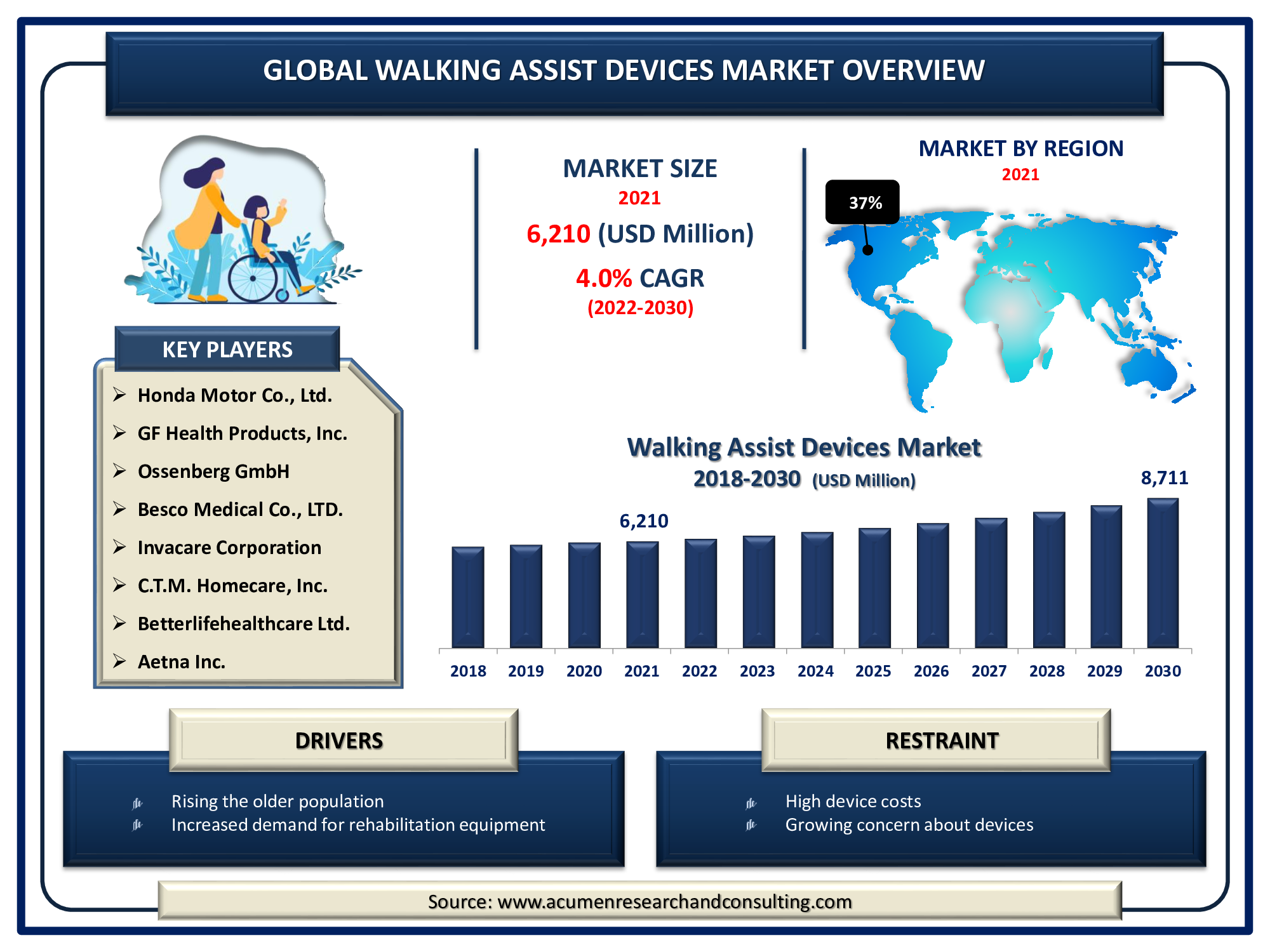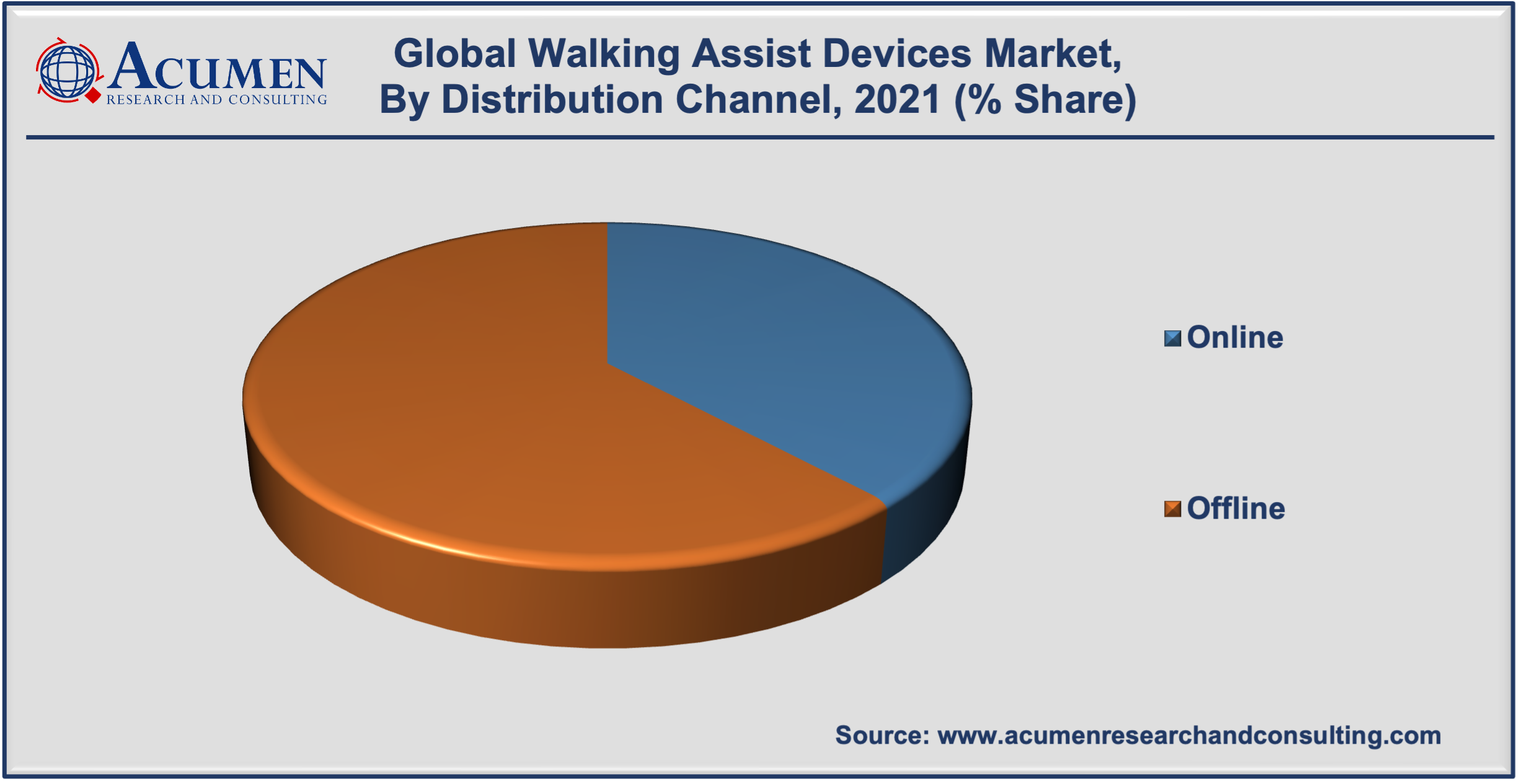Walking Assist Devices Market Analysis - Global Industry Size, Share, Trends and Forecast 2022 - 2030
Published :
Report ID:
Pages :
Format :
Walking Assist Devices Market Analysis - Global Industry Size, Share, Trends and Forecast 2022 - 2030
Report Coverage
- Industry Dynamics
- Market Size and Forecast Data
- Segment Analysis
- Competitive Landscape
- Regional Analysis with a Niche Focus on Country-Level Data
- High Level Analysis - Porter's, PESTEL, Value Chain, etc.
- Company Profiles of Key Players
- Option to Customize the Report As Per Your Specific Need
Request Sample Report
The Global Walking Assist Devices Market accounted for USD 6,210 Million in 2021 and is expected to reach the market value of USD 8,711 Million by 2030 at a CAGR of 4.0% during the forecast period from 2022 to 2030.

The constantly expanding elderly and generic populations, as well as increasing technological innovations in such devices, have all contributed to the growth of the global walking assist devices market over the past decades. Moreover, the rising demand for rehabilitation equipment, the rising prevalence of rheumatoid and osteoarthritis, and government initiatives in emerging economies to increase the sustainability of walking assist devices to a large consumer base are the major factors driving the walking assist devices market growth.
The Walking Assist Device is intended to be a walking training device with the capability of influencing the consumer to achieve efficient walking based on the inverse kinematics framework, which is a theory of vaguely humanoid walking. There is a wide range of walking assistance and autonomy aids available to assist old-aged people who have difficulty moving around safely and effectively. Also, because the likelihood of falling increases significantly with age and a fall can be dangerous, it stands to reason that a wide range of different assistive devices has been developed to provide support and protection to those who require it. They are also useful for patients undergoing rehabilitation after an accident. This category includes wheelchairs, walkers, gait belts and lifts vests, crutches, canes, power scooters, and other assistive devices.
Walking Assist Devices Market Dynamics
Walking Assist Devices Market Drivers
- Rising the older population
- Rapid technological advancement in healthcare facilities
- Growing prevalence of incapacitating neurological injuries and illnesses
- Increased demand for rehabilitation equipment
Walking Assist Devices Market Restraints
- High device costs
- Growing concern about devices
Walking Assist Devices Market Opportunity
- Rising government initiative to ensure adequate device supply
Report Coverage
| Market | Walking Assist Devices Market |
| Market Size 2021 | USD 6,210 Million |
| Market Forecast 2030 | USD 8,711 Million |
| CAGR During 2022 - 2030 | 4.0% |
| Analysis Period | 2018 - 2030 |
| Base Year | 2021 |
| Forecast Data | 2022 - 2030 |
| Segments Covered | By Product, By Distribution Channel, And By Geography |
| Regional Scope | North America, Europe, Asia Pacific, Latin America, and Middle East & Africa |
| Key Companies Profiled | Honda Motor Co., Ltd., GF Health Products, Inc., Ossenberg GmbH, Besco Medical Co., LTD., Invacare Corporation, C.T.M. Homecare Product, Inc., Betterlife healthcare Ltd., Pride Mobility Products Corp., Aetna Inc., Sunrise Medical (US) LLC, Permobil Inc., and Karma Healthcare Ltd. |
| Report Coverage |
Market Trends, Drivers, Restraints, Competitive Analysis, Player Profiling, Regulation Analysis |
| Customization Scope |
10 hrs of free customization and expert consultation |
Expansion of healthcare spending and government funding for robotic system innovation to promote a healthy lifestyle will significantly contribute to the global expansion of the walking assist devices market size throughout the forecast period. For instance, Panasonic Corporation has developed a mass-production prototype of its Walk Training Robot in April 2021, which is intended to provide efficient and safe walk instruction for senior people. Panasonic has been developing and demonstrating AI-powered walking training robotic systems to help people who are unable to walk but want to live a healthier life. Furthermore, increased awareness of direct-to-consumer marketing and e-commerce sales helps to expand walking assist device market trends.
The rapid advancement of technology in health care services is boosting the walking assist device market forward. Furthermore, rising government initiatives to improve the sustainability of walking assist devices for the elderly society, to meet customer expectations are expected to drive the global walking assist devices market in the coming years. Furthermore, as the prevalence of crippling neurobiological illnesses and conditions among patients rises, there is a growing market for walking assist devices. However, the rising prevalence of neurodegenerative disorders is expected to propel the global market forward in the coming years. Besides that, the inflated costs of walking assist devices, as well as some difficulties associated with walking assist devices, may hinder the growth of the global walking assist devices market. Additionally, technological advances are transforming existing assistive devices, which are expected to serve as market growth catalysts during the forecast period.
Walking Assist Devices Market Segmentation
The global walking assist devices market segmentation is based on the product, distribution channel and geographical region.
Walking Assist Devices Market By Product
- Gaits Belts & Lift Vests
- Walkers
- Crutches
- Wheelchairs
- Canes
- Power scooters
Based on the product, the walker segment is expected to hold significant market shares in 2021. A walker will help provide protection and strength while walking, as well as allow individuals to maintain weight-bearing restrictions. Since it has a wider base of support than a walking frame, it is more frequently used to stabilize patients with impaired balance and movement. Walkers are most commonly used by patients recovering from limb or spinal cord injuries. Patients who have trouble walking or those who have mild balance problems also use the device frequently. Walkers improve stability and mobility in people with lower extremity disorders by increasing the patient's support base and assisting the patient's weight.
Furthermore, the crunches segment is expected to grow at the fastest rate over the forecasted years. Medical crutches are a type of mobility aid that allows a person or patients to shift their body weight from their legs to their upper body. These have been used by people that suffer from short-term injury problems to chronic disabilities. The segment's growth is being driven by factors such as an increase in the number of collisions resulting in disability around the world, an increase in the incidence of lifelong handicaps, and the adoption of advanced medical crutches technologies.
Walking Assist Devices Market By Distribution Channel
- Online
- Offline

Based on the distribution channel, the online segment is projected to expand significantly and hold the largest walking assist devices market share over the forecast timeframe. This growth can be attributed to consumers' increased preference for the online platform in the aftermath of the Corona virus (COVID-19) outbreak, which resulted in global shutdowns and stay-at-home restrictions. The significant influences of major players' different online portals for Walking Assist Devices such as assistive devices and mobility scooters are expected to boost demand during the forecast period.
Walking Assist Devices Market Regional Outlook
North America
- U.S.
- Canada
Europe
- U.K.
- Germany
- France
- Spain
- Rest of Europe
Latin America
- Mexico
- Brazil
- Rest of Latin America
Asia-Pacific
- India
- Japan
- China
- Australia
- South Korea
- Rest of Asia-Pacific
The Middle East & Africa (MEA)
- Gulf Cooperation Council (GCC)
- South Africa
- Rest of the Middle East & Africa
North America will have the largest share of the global market in 2021, owing to increased technological advancement, the presence of key players, and an aging population. Furthermore, increased rental product activity, as well as exhausting neurological illnesses and conditions in this region, may lead to an increase in the use of walking assist devices. Furthermore, rising government reimbursement and economic assistance from other investment firms are expected to drive growth in the global walking assist devices market. North America has dominated the global market due to the rise in aging populations, the existence of well-developed healthcare organizations, technological developments forwarded by major players, and private organizations offering a variety of encouraging resources for the benefit of physically disabled people.
Walking Assist Devices Market Players
Some of the prominent global walking assist devices market companies are Honda Motor Co., Ltd., GF Health Products, Inc., Ossenberg GmbH, Besco Medical Co., LTD., Invacare Corporation, C.T.M. Homecare Product, Inc., Betterlife healthcare Ltd., Pride Mobility Products Corp., Aetna Inc., Sunrise Medical (US) LLC, Permobil Inc., and Karma Healthcare Ltd.
Frequently Asked Questions
How much was market size of global walking assist devices market in 2021?
The global walking assist devices market size accounted for USD 6,210 Million in 2021.
What will be the projected CAGR for global walking assist devices market during forecast period of 2022 to 2030?
The projected CAGR of walking assist devices during the analysis period of 2022 to 2030 is 4%.
Which are the prominent competitors operating in the market?
The prominent players of the global walking assist devices market involve Honda Motor Co., Ltd., GF Health Products, Inc., Ossenberg GmbH, Besco Medical Co., LTD., Invacare Corporation, C.T.M. Homecare Product, Inc., Betterlife healthcare Ltd., Pride Mobility Products Corp., Aetna Inc., Sunrise Medical (US) LLC, Permobil Inc., and Karma Healthcare Ltd.
Which region held the dominating position in the global walking assist devices market?
North America held the dominating share for walking assist devices during the analysis period of 2022 to 2030.
Which region exhibited the fastest growing CAGR for the forecast period of 2022 to 2030?
Asia-Pacific region exhibited fastest growing CAGR for walking assist devices during the analysis period of 2022 to 2030.
What are the current trends and dynamics in the global walking assist devices market?
Raising the older population, rapid technological advancement in healthcare facilities, and growing prevalence of incapacitating neurological injuries and illnesses are the prominent factors that fuel the growth of global walking assist devices market.
By segment product, which sub-segment held the maximum share?
Based on product, walkers segment held the maximum share for walking assist devices market in 2021.


